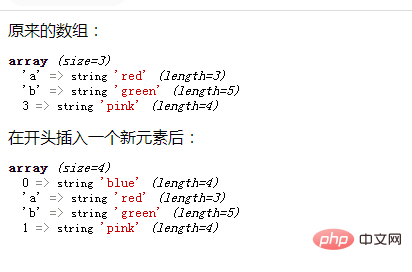How to add and delete elements to php array
Add method: 1. array_unshift() inserts elements at the beginning, the syntax is "array_unshift(array, element list)"; 2. array_push() inserts elements at the end, the syntax is "array_push(array, element)". Deletion method: 1. array_shift() deletes the first element, the syntax is "array_shift(array)"; 2. array_pop() deletes the last element, the syntax is "array_pop(array)".

The operating environment of this tutorial: windows7 system, PHP8.1 version, DELL G3 computer
php array adding elements Method
1. The array_unshift() function inserts new elements into the array
##array_unshift($array,$value1,$ value2...)The function can insert one or more new elements (key values) at the beginning of the array.
<?php $arr=array(10,12,20); array_unshift($arr,8,"9"); var_dump($arr); ?>
array_unshift($arr,8,9)It can be seen that two characters are inserted at the beginning of the $arr array new elements: the value "8" and the string "9", so the output result is:

<?php
header("Content-type:text/html;charset=utf-8");
$arr=array("a"=>"red","b"=>"green",3=>"pink");
echo "原来的数组:";
var_dump($arr);
array_unshift($arr,"blue");
echo "在开头插入一个新元素后:";
var_dump($arr);
?>
2. The array_push() function inserts new elements into the array
array_push($array,$value1,$value2...)The function can insert one or more elements (key values) at the end of the array.
<?php $arr=array(10,12,20); array_push($arr,8,"9",3.14); var_dump($arr); ?>
array_push($arr,8,"9",3.14)It can be seen that in the $arr array Insert 3 elements at the end: integer "8", string "9" and floating point number "3.14", so the output result is:
<?php
header("Content-type:text/html;charset=utf-8");
$arr=array("a"=>"red","b"=>"green",3=>"pink");
array_push($arr,8,"9",3.14);
var_dump($arr);
?>3. The array_pad() function inserts new elements into the array
array_pad($array,$size,$value)The function can insert a key value $value into the array $array, thereby filling the array to the specified The length of $size. (The $size parameter can be understood as the final number of elements in the array, that is, the length of the array after the insertion operation).
<?php $arr=array(10,12,20); $result =array_pad($arr,5,1); var_dump($result); ?>
array_pad($arr,5,1), $size## The value of # is 5, then there are 5 elements in the array after the insertion operation; and there are 3 elements in the original array, then only 2 elements need to be inserted. And because the inserted value $value is 1, you only need to insert 2 elements with the value "1". Therefore, the output result is:
As can be seen from the above example, the array_pad() function can insert elements at the end of the array. In fact, the array_pad() function can also insert elements at the end of the array. Insert elements at the beginning; and the key is the
parameter. The
parameter has three values: if
- is a positive number, elements will be inserted at the end of the array;
If
is a negative number, insert the element at the beginning of the array; - If its absolute value is less than or equal to the length of the
- $array
array, no element will be inserted. Insert operation.
<?php $arr=array(10,12,20); $result =array_pad($arr,-5,1); var_dump($result); $result =array_pad($arr,3,1); var_dump($result); $result =array_pad($arr,2,1); var_dump($result); ?>
Copy after loginThe output result is:

can also be an array, that is Insert an entire array, and the original array will become a two-dimensional array. <div class="code" style="position:relative; padding:0px; margin:0px;"><pre class='brush:php;toolbar:false;'><?php
header("Content-type:text/html;charset=utf-8");
$arr=array(10,12,20);
$result =array_pad($arr,-5,array("张三",25,"男"));
var_dump($result);
?></pre><div class="contentsignin">Copy after login</div></div>The output result is:
array_splice($array,$start,$length,$value)
The function is a powerful function that can be used to delete array elements, replace array elements, and also insert array elements (just set the parameters $length can be set to 0). When
, then the parameter $start can specify the position (subscript) to start inserting, and the parameter $value can The insertion value can be specified (if there are multiple values, it needs to be set as an array). Let’s take a closer look at the following example:
<?php
header("Content-type:text/html;charset=utf-8");
$arr1=array(10,12,20);
array_splice($arr1,0,0,"1");
var_dump($arr1);
$arr2=array(10,12,20);
array_splice($arr2,0,0,array("1",25,"3"));
var_dump($arr2);
?>The output result is:
从上例可以看出,当$start=0时,会将$value值按顺序的插入到数组开头。那么想要在数组末尾插入元素要怎么弄?
简单,将$start的值设置为“数组长度值”,即count($arr)即可。
<?php
header("Content-type:text/html;charset=utf-8");
$arr1=array(10,12,20);
array_splice($arr1,count($arr1),0,"1");
var_dump($arr1);
$arr2=array(10,12,20);
array_splice($arr2,count($arr2),0,array("1",25,"3"));
var_dump($arr2);
?>输出结果为:
php数组删除元素的方法
1、array_shift()函数删除第一个元素
array_shift() 函数用于删除数组中的第一个元素,并返回被删除的元素。
注释:如果键名是数字的,所有元素都将获得新的键名,从 0 开始,并以 1 递增
<?php
header("Content-type:text/html;charset=utf-8");
$arr=array(10,12,20,25,24);
echo "原数组:";
var_dump($arr);
array_shift($arr);
echo "删除后的数组:" ;
var_dump($arr);
?>2、array_pop()函数删除最后一个元素
array_pop() 函数删除数组中的最后一个元素。
<?php
header("Content-type:text/html;charset=utf-8");
$arr=array(10,12,20,25,24);
echo "原数组:";
var_dump($arr);
array_pop($arr);
echo "删除后的数组:" ;
var_dump($arr);
?>3、array_unique()函数移除重复元素
array_unique() 函数用于移除数组中重复的值。如果两个或更多个数组值相同,只保留第一个值,其他的值被移除。
注释:被保留的数组将保持第一个数组项的键名类型。
array_unique(array,sortingtype)
| 参数 | 描述 |
|---|---|
| array | 必需。规定数组。 |
| sortingtype | 可选。规定排序类型。可能的值:
|
<?php
header("Content-type:text/html;charset=utf-8");
$arr=array(1,2,3,4,4,2,6);
echo "原数组:";
var_dump($arr);
echo "删除重复值后:" ;
var_dump(array_unique($arr));
?>4、array_splice()函数删除任意位置元素
array_splice()是一个强大的函数,有多重功能:可以插入数组元素、可以替换数组元素,当然也可以删除数组元素(毕竟array_splice()函数的本职工作是删除指定元素并用其它值取代)。
array_splice()函数可以从指定位置开始删除指定个数的元素。
array_splice($arr,$start)会删除从$start位置开始的所有元素删除。
<?php
header("Content-type:text/html;charset=utf-8");
$arr=array(10,12,20,25,24);
echo "原数组:";
var_dump($arr);
echo "删除后的数组:" ;
array_splice($arr,2);
var_dump($arr);
?>$start参数有三种取值情况:
为正数,那么从$start位置开始,往后删除;
为0,那么从第一个元素开始,往后删除;
为负数,则从距离 $arr 末端 -start 的位置开始,从后往前删除。例如 -2 意味着从数组的倒数第二个元素开始。
<?php
header("Content-type:text/html;charset=utf-8");
$arr=array(10,12,20,25,24);
echo "原数组:";
var_dump($arr);
echo "删除后的数组:" ;
array_splice($arr,-2);
var_dump($arr);
?>array_splice()函数是强大的,可以删除多个元素,也可只删除一个元素,那就需要给该函数指定一个$length参数(第三个参数),该参数用来规定删除的元素个数。
<?php
header("Content-type:text/html;charset=utf-8");
$arr=array(10,12,20,25,24);
echo "原数组:";
var_dump($arr);
echo "删除后的数组:" ;
array_splice($arr,2,1);
var_dump($arr);
?>$length参数也有三种取值情况:
为正数,那么就表示删除 length 个元素;
为负数,那么将删除从 start 开始,到数组末尾倒数 length 为止的所有元素;
如果省略,那么将删除从 start 开始,一直到数组末尾的所有元素。
<?php
header("Content-type:text/html;charset=utf-8");
$arr=array(10,12,20,25,24);
echo "原数组:";
var_dump($arr);
echo "删除后的数组:" ;
array_splice($arr,2,-1);
var_dump($arr);
?>$length参数还可以为0,那么就表示不删除元素,可以和该函数的第四个参数$value相配合,进行插入操作(这里就不做具体介绍了)。
5、unset()函数删除指定下标元素
unset()函数可以删除指定下标(键名)的一个数组元素
<?php
header('content-type:text/html;charset=utf-8');
$arr = array(0 => "a", 1 => "b", 2 => "c");
echo "原数组:";
var_dump($arr);
echo "删除后的数组:" ;
unset($arr[1]);
//↑ 你想删除的key
var_dump($arr);
?>推荐学习:《PHP视频教程》
The above is the detailed content of How to add and delete elements to php array. For more information, please follow other related articles on the PHP Chinese website!

Hot AI Tools

Undresser.AI Undress
AI-powered app for creating realistic nude photos

AI Clothes Remover
Online AI tool for removing clothes from photos.

Undress AI Tool
Undress images for free

Clothoff.io
AI clothes remover

Video Face Swap
Swap faces in any video effortlessly with our completely free AI face swap tool!

Hot Article

Hot Tools

Notepad++7.3.1
Easy-to-use and free code editor

SublimeText3 Chinese version
Chinese version, very easy to use

Zend Studio 13.0.1
Powerful PHP integrated development environment

Dreamweaver CS6
Visual web development tools

SublimeText3 Mac version
God-level code editing software (SublimeText3)

Hot Topics
 1389
1389
 52
52
 PHP 8.4 Installation and Upgrade guide for Ubuntu and Debian
Dec 24, 2024 pm 04:42 PM
PHP 8.4 Installation and Upgrade guide for Ubuntu and Debian
Dec 24, 2024 pm 04:42 PM
PHP 8.4 brings several new features, security improvements, and performance improvements with healthy amounts of feature deprecations and removals. This guide explains how to install PHP 8.4 or upgrade to PHP 8.4 on Ubuntu, Debian, or their derivati
 7 PHP Functions I Regret I Didn't Know Before
Nov 13, 2024 am 09:42 AM
7 PHP Functions I Regret I Didn't Know Before
Nov 13, 2024 am 09:42 AM
If you are an experienced PHP developer, you might have the feeling that you’ve been there and done that already.You have developed a significant number of applications, debugged millions of lines of code, and tweaked a bunch of scripts to achieve op
 How To Set Up Visual Studio Code (VS Code) for PHP Development
Dec 20, 2024 am 11:31 AM
How To Set Up Visual Studio Code (VS Code) for PHP Development
Dec 20, 2024 am 11:31 AM
Visual Studio Code, also known as VS Code, is a free source code editor — or integrated development environment (IDE) — available for all major operating systems. With a large collection of extensions for many programming languages, VS Code can be c
 Explain JSON Web Tokens (JWT) and their use case in PHP APIs.
Apr 05, 2025 am 12:04 AM
Explain JSON Web Tokens (JWT) and their use case in PHP APIs.
Apr 05, 2025 am 12:04 AM
JWT is an open standard based on JSON, used to securely transmit information between parties, mainly for identity authentication and information exchange. 1. JWT consists of three parts: Header, Payload and Signature. 2. The working principle of JWT includes three steps: generating JWT, verifying JWT and parsing Payload. 3. When using JWT for authentication in PHP, JWT can be generated and verified, and user role and permission information can be included in advanced usage. 4. Common errors include signature verification failure, token expiration, and payload oversized. Debugging skills include using debugging tools and logging. 5. Performance optimization and best practices include using appropriate signature algorithms, setting validity periods reasonably,
 How do you parse and process HTML/XML in PHP?
Feb 07, 2025 am 11:57 AM
How do you parse and process HTML/XML in PHP?
Feb 07, 2025 am 11:57 AM
This tutorial demonstrates how to efficiently process XML documents using PHP. XML (eXtensible Markup Language) is a versatile text-based markup language designed for both human readability and machine parsing. It's commonly used for data storage an
 PHP Program to Count Vowels in a String
Feb 07, 2025 pm 12:12 PM
PHP Program to Count Vowels in a String
Feb 07, 2025 pm 12:12 PM
A string is a sequence of characters, including letters, numbers, and symbols. This tutorial will learn how to calculate the number of vowels in a given string in PHP using different methods. The vowels in English are a, e, i, o, u, and they can be uppercase or lowercase. What is a vowel? Vowels are alphabetic characters that represent a specific pronunciation. There are five vowels in English, including uppercase and lowercase: a, e, i, o, u Example 1 Input: String = "Tutorialspoint" Output: 6 explain The vowels in the string "Tutorialspoint" are u, o, i, a, o, i. There are 6 yuan in total
 Explain late static binding in PHP (static::).
Apr 03, 2025 am 12:04 AM
Explain late static binding in PHP (static::).
Apr 03, 2025 am 12:04 AM
Static binding (static::) implements late static binding (LSB) in PHP, allowing calling classes to be referenced in static contexts rather than defining classes. 1) The parsing process is performed at runtime, 2) Look up the call class in the inheritance relationship, 3) It may bring performance overhead.
 What are PHP magic methods (__construct, __destruct, __call, __get, __set, etc.) and provide use cases?
Apr 03, 2025 am 12:03 AM
What are PHP magic methods (__construct, __destruct, __call, __get, __set, etc.) and provide use cases?
Apr 03, 2025 am 12:03 AM
What are the magic methods of PHP? PHP's magic methods include: 1.\_\_construct, used to initialize objects; 2.\_\_destruct, used to clean up resources; 3.\_\_call, handle non-existent method calls; 4.\_\_get, implement dynamic attribute access; 5.\_\_set, implement dynamic attribute settings. These methods are automatically called in certain situations, improving code flexibility and efficiency.


















